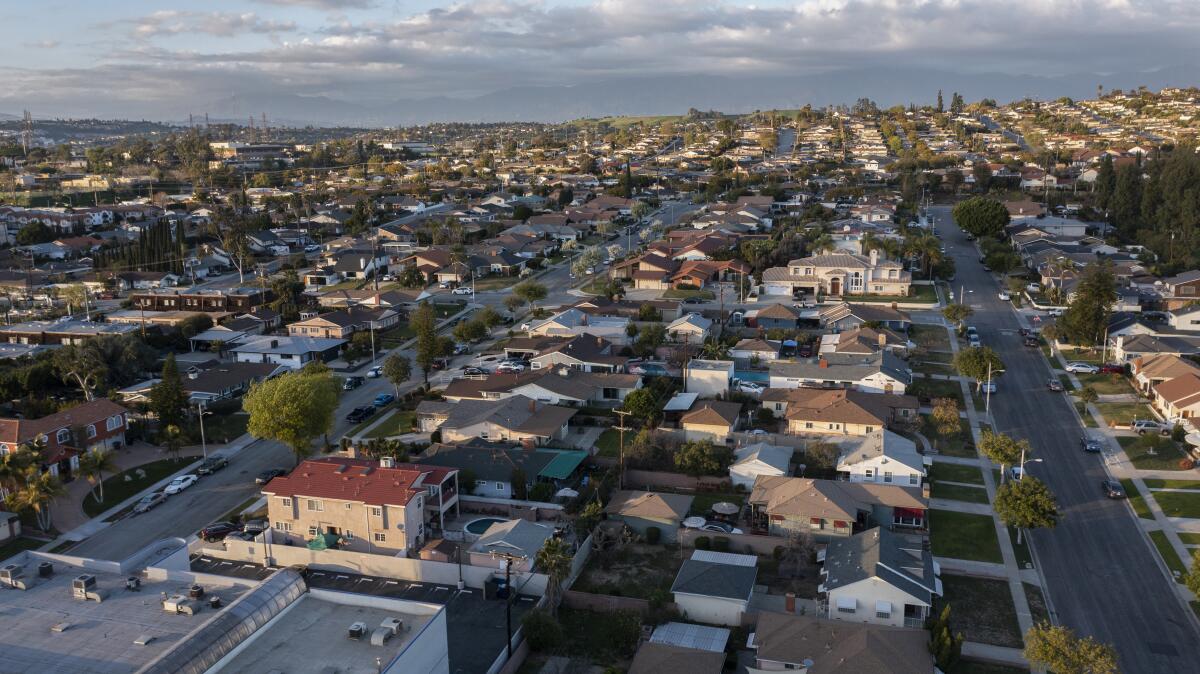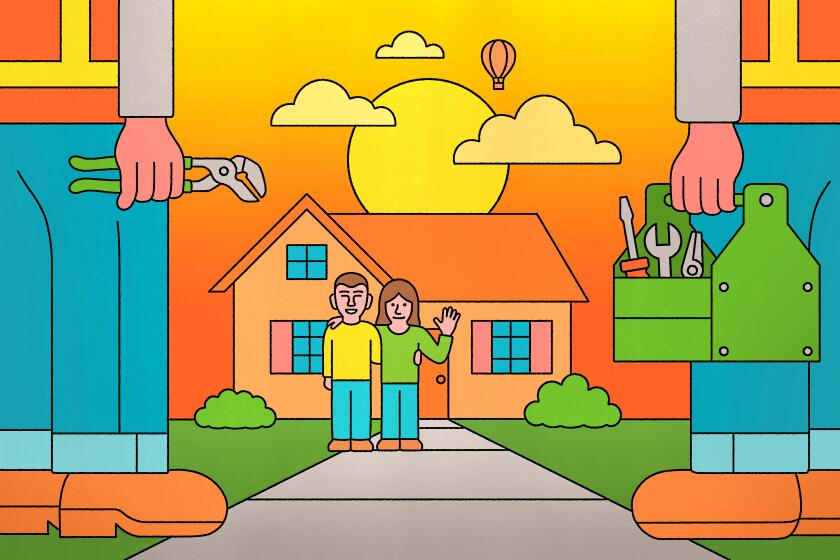So you have an unpermitted ADU? Here’s how to bring it up to code

- Share via
California is in the midst of a building boom for accessory dwelling units, which accounted for almost one-fifth of the housing units permitted and built in 2022.
The number of unpermitted ADUs already in existence is jaw-dropping too.
Studies done between 2010 and 2020 found that 11% to 66% of the single-family homes in selected parts of Los Angeles, Oakland and Berkeley had unpermitted units. In fact, one researcher who examined the communities between Long Beach and downtown Los Angeles found that more than 75% of the housing units added between 1991 and 2010 were unpermitted. A UCLA professor estimated in 2018 that Los Angeles had at least 50,000 unpermitted secondary units on single-family lots.
Unauthorized ADUs proliferated in large part because many California cities made it well-nigh impossible to get permits for them. Those barriers did nothing to reduce the demand for living spaces, particularly from lower-income households whose members spanned multiple generations. “If people don’t have housing, they will create housing for themselves and their families,” said Renée Schomp, former director of the Napa Sonoma ADU Center.
But owning an unpermitted ADU carries risks, especially if you rent it out. You’ll face fines, insurance problems and, potentially, lawsuits from tenants.
The incentives for complying may not be enough, though, to persuade you to get the necessary permits. It can take almost as long to get them as it would for a new ADU, and the cost of bringing your unit into compliance can be quite high.
That’s because unpermitted ADUs can have hidden problems in their foundation, framing, wiring and plumbing that can be expensive to fix. “If it’s a gorgeous unit, that doesn’t mean anything,” said Avi Levi of Levi Design Build, a developer who does most of his work these days on ADUs.
Sign up for You Do ADU
Our six-week newsletter will help you make the right decision for you and your property.
You may occasionally receive promotional content from the Los Angeles Times.
Common compliance issues
One reason people build dwelling units without permits is that the time-consuming process of getting approvals can raise a project’s price tag by thousands of dollars. But with no inspectors to ensure that the work complies with city codes, nothing stops a contractor from falling short of the local standards — inadvertently or not.
“People don’t get it,” Levi said. “When they’re doing work without a permit, they’re basically letting the person that did the job get away with whatever they wanted to get away with.”
Steven Frasher, spokesman for L.A. County Public Works, offered a list by email when asked what problems the county’s inspectors observed most often. “Improper exiting, improper venting of heating devices, undersized wiring, or improper electrical grounding, to name a few, can lead to life safety issues that are both long-term [chronic] or short-term [acute] exposure risks,” Frasher said. “Most people are aware of acute risks such as fire, but they tend to not pay enough attention to the chronic risks such as headaches, nausea, and breathing problems can be caused by unpermitted building materials, poor ventilation, and mold caused by improper construction methods.”
And even if the contractor did everything by the book, that may not be enough to bring your unit into compliance years later. Although a state law passed in 2018 allows local officials to judge your ADU by the building codes that were in place when it was built, they have the discretion to insist that you upgrade to newer, more stringent standards.
The city of Los Angeles, for example, requires unpermitted ADUs to comply with the 2022 state building codes and at least two mandates that probably didn’t exist when your ADU was built: the state’s energy efficiency standards and the city’s Green Building codes.
Builders and the Casita Coalition, a housing advocacy group that backs ADUs, outlined eight compliance issues frequently encountered by homeowners seeking permits for existing units:
- Foundation: Most ADUs are converted garages that have a concrete slab foundation that is not stable enough for dwellings — and if the garage was built before 1940, they may have no foundation. In addition to a foundation supported by a sufficient number of footings, these units may need a layer of vapor retarder — a feature not required in garages.
- Framing: Unpermitted ADUs often are missing some of the structural safety features that dwelling spaces require, such as the full complement of ceiling joists and braced wall panels. Converted garages may also have kept the garage door as an exterior wall, which is a no-no, said Danny Shuster of Los Angeles-based Construction & Consulting Services.
- Wiring and plumbing: In 90% of the unpermitted ADUs he’s seen, Levi said, the wiring and plumbing aren’t up to building-code standards. And in Los Angeles, ADUs must have a separate electrical panel and their own water shut-off valve, along with a source of heat that’s not a portable space heater.
- Utility connections and meters: Depending on your city’s requirements, you may need to have separate meters for your ADU’s utilities (which you might want anyway for a rental unit). More significantly, jurisdictions have standards for how and where the ADU’s sewer line connects to the main sewer in the street, and unpermitted ADUs rarely comply, Shuster said.
- Energy efficiency: The state’s standards for energy efficient buildings, known as Title 24, are designed to cut electricity and gas use by sealing buildings off better from the elements. But they could force you to replace old windows that leak heat.
- Emergency egress: Every bedroom must have an alternate way out in case the door is blocked by fire. As a result, you may have to install a bedroom window large enough for an adult to climb out of.
- Water heater: If your ADU’s gas water heater is in a bedroom, it will need to be enclosed in a closet that meets state rules. It will also need to be at least five feet from the property line, as will any heating or cooling appliances, Shuster said.
- Firewall: Any exterior wall of an ADU that’s less than 5 feet from the property line must be built to suppress fire for at least 1 hour. Unless your ADU was built fairly recently, you’ll probably have to retrofit it with fire-resistant boards on the inside of the wall.
It’s conceivable that your ADU may not even be permittable, thanks to a noncompliant feature that would be prohibitively expensive to fix — for example, a ceiling that’s too low or the lack of a separate entrance. Another issue for converted garages, Shuster said, is that the exterior walls may have been extended to allow for a larger ADU. If the ADU is closer to the property line than current zoning rules allow, he said, only the portion representing the original garage’s footprint will be grandfathered — the walls and roofline for the additional space will have to be moved back. Ouch.
Fully permitted accessory dwelling units are so new, appraisers say, there’s too little information to say with much certainty how much value they add to a home.
The path to permits
Not too long ago, there was no way to bring an unpermitted ADU into compliance if it violated setback requirements, limits on lot coverage or other zoning rules. If code enforcers cited your unit, you’d probably have to decide whether to return the space to its original use (e.g., a garage) or dismantle it.
Senate Bill 1069, which lawmakers passed in 2016 to make it easier to build ADUs, forced cities to issue permits “for any existing structure that had been or could be converted to an ADU, so that informal units had a path to safety,” Denise Pinkston, president of the Casita Coalition and a key proponent of the bill, said in an email. Now, Pinkston said, the main impediments are the cost of upgrades, the shortage of financing options, and a general mistrust of government, including fear of rent control among ADU owners, she said.
Nevertheless, contractors say they’re being approached more and more frequently by owners of unpermitted ADUs who are thinking about applying for permits. Levi said he gets at least two such calls a week — sometimes from people who were buying or had bought a lot with an unpermitted ADU, but mainly from property owners who had deliberately built units without getting permits.
About 80% of the time, he said, the ADU is a converted garage. And most of the calls are coming from people who’ve already gotten a citation from local authorities or who know they’re about to get one, Levi said.
Why do so many projects take months longer than expected and go over budget? ADU experts say it’s often because of problems on your site that could have been averted with better preparation.
How to get started
If you own an unpermitted ADU, chances are good that you’re well aware of the problem. Either you decided to forgo permits when you built it; or, if the ADU was on the property when you bought it, the seller’s agent and the reports you received from the inspector and the title insurance company told you that the space wasn’t legal. But if you have any doubt, your local government’s planning and building-and-safety departments will have records of any permits or certificates of occupancy obtained for your ADU. Many cities, including Los Angeles, enable you to do this online.
Seeking permits retroactively for an ADU will put you in an uncomfortable spot, Levi said: Once you reveal to the city that you have a potentially unsafe dwelling, you’ll have to either bring it into compliance or stop using it as a living space — and maybe even demolish it, depending on how severe the safety problems are.
So the first step is to find out as much as you can from your city (or your county, if you live in an unincorporated area) before outing your noncompliant unit. Some jurisdictions, including San Francisco and Milpitas, will try to help you figure out how much work you’ll have to do to meet current codes before you seek the necessary permits. And a few, such as Santa Cruz County, will allow you to keep renting out the unit without meeting all of today’s building codes, as long as your unit meets health and safety standards.
Pasadena has even offered local homeowners financial assistance to bring existing ADUs up to code through its Second Unit ADU Program, but it’s not taking new applications at the moment. According to the Pasadena Department of Housing’s website, “The application window is tentatively scheduled to open back up in summer 2023.”
The city of Los Angeles offers a preliminary plan check service (for a fee of at least $227) that can identify building and zoning issues in your plans up front, as well as a call center to answer your questions about local codes, Frank Lara of the L.A. Department of Building & Safety said via email. He also said that merely seeking permits won’t cause an ADU owner to be cited for code violations — the city issues citations in response to complaints, not permit applications.
(To ease the path to permits, the L.A. City Council approved a motion in April to allow owners of unpermitted ADUs to get city approvals without first having to return the unit to its original use — for example, turning a converted garage ADU back into a fully permitted garage. The motion also called for the development of an amnesty program for legalizing unpermitted ADUs, although it set no deadline.)
When taking on a project of this size and complexity, you’re going to need to hire professionals -- contractors, architects and others. Here’s how.
Looking behind the walls
Next, you’ll want to get some professional help (for your project, not for you personally — at least not at this juncture). You’ll need a licensed architect or structural engineer to sign off on your plans and a licensed contractor to do the work, but first you may want to consult with a pro who can give you a rough idea of what your ADU might require. That way you’ll at least know the scale of what you’re getting yourself into.
The process of obtaining permits starts with you submitting for review an “as built” ADU plan that hews closely to the current structure. “The city’s going to give their own comments about what they want us to comply with — what they will allow and what they will not allow,” Levi said, adding that the plans will go through several revisions and reviews before they’re approved.
How long that process takes will depend on whether you’re in a historic preservation overlay zone, an environmentally sensitive area or other locale that requires extra layers of scrutiny, Shuster said, adding, “It could take a few short weeks; it could take months.”
Once the plans are approved — and remember, this hurdle is significantly lower than it used to be — building and safety inspectors will come out to see how much work needs to be done to bring your unit into compliance. This preconstruction inspection is also a deconstruction inspection, as inspectors will want to tear up walls to check the condition of the wiring and plumbing behind them, as well as looking at the footings under the foundation and other important and potentially inadequate features.
Shuster said these inspections play out in one of three ways, the first being that the unit has to be gutted to expose the framing and foundation because the inspector thinks everything’s out of compliance. He’s seen this happen to maybe 10% of the units he’s worked on, and it came as no surprise because they were in such bad shape. The second possibility is that the inspector says the unit appears to be largely in compliance and pokes the minimum number of holes in the walls. That happens less than 10% of the time, Shuster said.
The most common scenario, he said, is that inspectors will say the unit looks OK but still want to look at the foundation and the framing, measure the insulation, inspect the plumbing and piping, check the wiring and the electrical panel. They may start by pointing out four or five locations where they want the frame or foundation exposed, then ask for more based on what they see.
You’ll probably need some kind of loan to help pay for an ADU. Your options will depend on your income, your home equity and your current mortgage.
How much is this going to cost?
Shuster said that bringing a converted garage into compliance would cost $20,000 to $30,000 under the best-case scenario, and possibly more than $100,000. Levi pegged the cost of legalizing a garage ADU at $50,000 to $130,000.
The least expensive job is still pretty costly because of the up-front expense of developing plans and getting them approved. The Casita Coalition estimated that the price tag for plans and permits started at $10,000 and went up from there.
In addition, once your ADU is officially on the city’s books, its value will be added to your property tax assessment, increasing your property taxes.
On the other hand, an unpermitted ADU can prove costly too.
It’s not just the prospect of getting hit with one or more citations for code violations if someone reports you to the city. It’s also what happens after the citation is issued.
If you have tenants, the Casita Coalition says, you may have to cover their relocation costs and reimburse them for the rent they’d paid. And even if you aren’t cited by the city, your tenant may sue you for providing seriously substandard housing, potentially collecting extra damages in addition to recovering their rent payments.
Another issue is that your insurer could exclude unpermitted structures from your coverage, said Janet Ruiz, a spokesperson for the Insurance Information Institute. If there’s a fire or some other kind of damage to that property, you could be on the hook for the entire loss.
About The Times Utility Journalism Team
This article is from The Times’ Utility Journalism Team. Our mission is to be essential to the lives of Southern Californians by publishing information that solves problems, answers questions and helps with decision making. We serve audiences in and around Los Angeles — including current Times subscribers and diverse communities that haven’t historically had their needs met by our coverage.
How can we be useful to you and your community? Email utility (at) latimes.com or one of our journalists: Jon Healey, Ada Tseng, Jessica Roy and Karen Garcia.
More to Read
Sign up for You Do ADU
Our six-week newsletter will help you make the right decision for you and your property.
You may occasionally receive promotional content from the Los Angeles Times.











